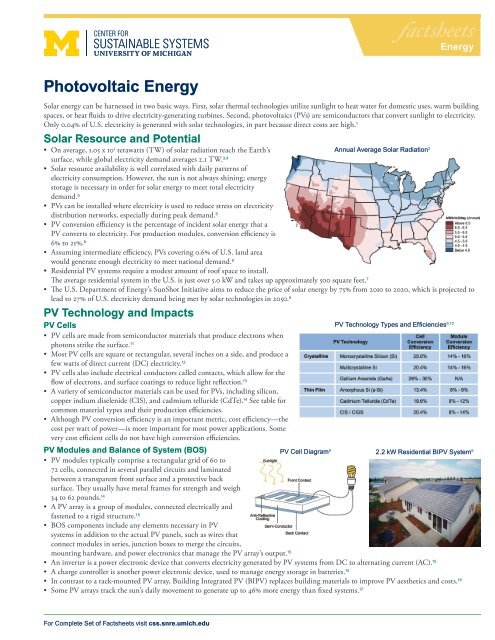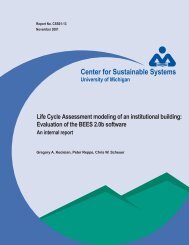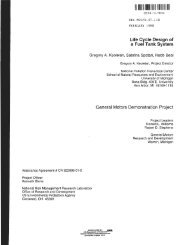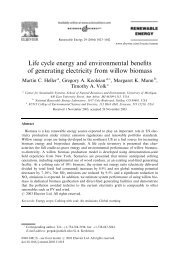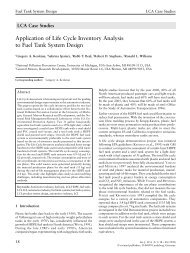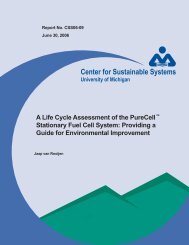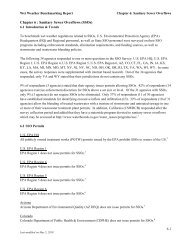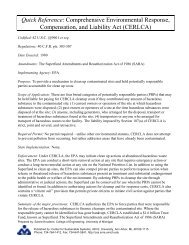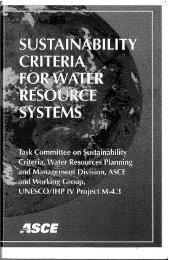Photovoltaic Energy - Center for Sustainable Systems - University of ...
Photovoltaic Energy - Center for Sustainable Systems - University of ...
Photovoltaic Energy - Center for Sustainable Systems - University of ...
Create successful ePaper yourself
Turn your PDF publications into a flip-book with our unique Google optimized e-Paper software.
<strong>Energy</strong><br />
<strong>Photovoltaic</strong> <strong>Energy</strong><br />
Solar energy can be harnessed in two basic ways. First, solar thermal technologies utilize sunlight to heat water <strong>for</strong> domestic uses, warm building<br />
spaces, or heat fluids to drive electricity-generating turbines. Second, photovoltaics (PVs) are semiconductors that convert sunlight to electricity.<br />
Only 0.04% <strong>of</strong> U.S. electricity is generated with solar technologies, in part because direct costs are high. 1<br />
Solar Resource and Potential<br />
• On average, 1.05 x 10 5 terawatts (TW) <strong>of</strong> solar radiation reach the Earth’s<br />
surface, while global electricity demand averages 2.1 TW. 3,4<br />
• Solar resource availability is well correlated with daily patterns <strong>of</strong><br />
electricity consumption. However, the sun is not always shining; energy<br />
storage is necessary in order <strong>for</strong> solar energy to meet total electricity<br />
demand. 5<br />
• PVs can be installed where electricity is used to reduce stress on electricity<br />
distribution networks, especially during peak demand. 5<br />
• PV conversion efficiency is the percentage <strong>of</strong> incident solar energy that a<br />
PV converts to electricity. For production modules, conversion efficiency is<br />
6% to 21%. 6<br />
• Assuming intermediate efficiency, PVs covering 0.6% <strong>of</strong> U.S. land area<br />
would generate enough electricity to meet national demand. 6<br />
• Residential PV systems require a modest amount <strong>of</strong> ro<strong>of</strong> space to install.<br />
The average residential system in the U.S. is just over 5.0 kW and takes up approximately 500 square feet. 7<br />
• The U.S. Department <strong>of</strong> <strong>Energy</strong>’s SunShot Initiative aims to reduce the price <strong>of</strong> solar energy by 75% from 2010 to 2020, which is projected to<br />
lead to 27% <strong>of</strong> U.S. electricity demand being met by solar technologies in 2050. 6<br />
PV Technology and Impacts<br />
PV Cells<br />
• PV cells are made from semiconductor materials that produce electrons when<br />
photons strike the surface. 11<br />
• Most PV cells are square or rectangular, several inches on a side, and produce a<br />
few watts <strong>of</strong> direct current (DC) electricity. 12<br />
• PV cells also include electrical conductors called contacts, which allow <strong>for</strong> the<br />
flow <strong>of</strong> electrons, and surface coatings to reduce light reflection. 13<br />
• A variety <strong>of</strong> semiconductor materials can be used <strong>for</strong> PVs, including silicon,<br />
copper indium diselenide (CIS), and cadmium telluride (CdTe). 14 See table <strong>for</strong><br />
common material types and their production efficiencies.<br />
• Although PV conversion efficiency is an important metric, cost efficiency—the<br />
cost per watt <strong>of</strong> power—is more important <strong>for</strong> most power applications. Some<br />
very cost efficient cells do not have high conversion efficiencies.<br />
Annual Average Solar Radiation 2<br />
PV Technology Types and Efficiencies 6,10<br />
PV Modules and Balance <strong>of</strong> System (BOS)<br />
• PV modules typically comprise a rectangular grid <strong>of</strong> 60 to<br />
72 cells, connected in several parallel circuits and laminated<br />
between a transparent front surface and a protective back<br />
surface. They usually have metal frames <strong>for</strong> strength and weigh<br />
34 to 62 pounds. 14<br />
• A PV array is a group <strong>of</strong> modules, connected electrically and<br />
fastened to a rigid structure. 15<br />
• BOS components include any elements necessary in PV<br />
systems in addition to the actual PV panels, such as wires that<br />
connect modules in series, junction boxes to merge the circuits,<br />
PV Cell Diagram 8 2.2 kW Residential BIPV System 9<br />
mounting hardware, and power electronics that manage the PV array’s output. 15<br />
• An inverter is a power electronic device that converts electricity generated by PV systems from DC to alternating current (AC). 15<br />
• A charge controller is another power electronic device, used to manage energy storage in batteries. 15<br />
• In contrast to a rack-mounted PV array, Building Integrated PV (BIPV) replaces building materials to improve PV aesthetics and costs. 16<br />
• Some PV arrays track the sun’s daily movement to generate up to 46% more energy than fixed systems. 17<br />
For Complete Set <strong>of</strong> Factsheets visit css.snre.umich.edu
PV Installation, Manufacturing, and Cost<br />
• Global cumulative capacity <strong>of</strong> PV systems grew 73-fold between 2000 and 2012, reaching<br />
more than 100 GW. Germany (32 GW), Italy (16 GW), and China (8.3 GW) had the<br />
highest installed PV capacities and made up over half <strong>of</strong> total global capacity. 18<br />
• The U.S. installed 3.3 GW <strong>of</strong> PV in 2012, raising total U.S. PV capacity to 7.8 GW. 18<br />
• PV module prices, a larges part <strong>of</strong> total system cost, fell 62% from 2008 to 2011. 16<br />
• Global investment in solar research and development R&D should further reduce PV<br />
production costs. In 2012, $4.9 billion was invested in solar R&D, higher than any other<br />
renewable energy technology. 19<br />
• PV systems or components are manufactured in 99 factories across 26 states. 14<br />
• Between 2000 and 2010, U.S. market share <strong>of</strong> PV production dropped from 30% to 7%. 20<br />
• PV energy costs range from 15¢ to 64¢/kWh in the U.S., depending on system size. 21<br />
Retail electricity averages 10¢/kWh <strong>for</strong> all users and 12¢/kWh <strong>for</strong> residential. 1<br />
<strong>Energy</strong> Per<strong>for</strong>mance and Environmental Impact<br />
• Net energy ratio compares the life cycle energy output <strong>of</strong> a PV system to its life cycle<br />
primary energy input. One study showed that amorphous silicon PVs generate 3 to 6 times<br />
more energy than are required to produce them. 22<br />
• Recycling multi-crystalline cells can reduce manufacturing energy over 50%. 23<br />
• Although pollutants and toxic substances are emitted during PV manufacturing, life cycle<br />
emissions are low. For example, the life cycle emissions <strong>of</strong> thin-film CdTe are roughly 14 g<br />
CO 2<br />
e per kWh delivered, far below electricity sources such as coal (1,001 g CO 2<br />
e/kWh). 24,25<br />
• PVs can reduce environmental impacts associated with fossil fuel electricity generation; <strong>for</strong><br />
example, thermoelectric plants use 23 gallons <strong>of</strong> water to produce one kWh <strong>of</strong> electricity. 26<br />
U.S. air pollutant emissions were 826.7 kg CO 2<br />
/MWh, 1.8 kg SO 2<br />
/MWh, and 0.8 kg NO x<br />
/<br />
MWh, <strong>for</strong> the 2.87 x 10 9 MWh <strong>of</strong> fossil fuel electricity generated in 2010. 1<br />
Solutions and <strong>Sustainable</strong> Actions<br />
Policies Promoting Renewables<br />
• PV energy costs are currently higher than conventional electricity; however, the price consumers pay <strong>for</strong> electricity does not cover externalities<br />
such as the cost <strong>of</strong> health effects from air pollution, environmental damage from resource extraction, or long-term nuclear waste storage.<br />
Policies that support PVs can address these externalities to make PV energy more cost-competitive. 27<br />
• Proposed carbon cap-and-trade policies would work in favor <strong>of</strong> PVs by increasing the cost <strong>of</strong> fossil fuel energy generation. 28<br />
• PV policy incentives include renewable portfolio standards (RPS), feed-in tariffs (FIT), capacity rebates, and net metering. 29<br />
¤ ¤ An RPS requires electricity providers to obtain a minimum fraction <strong>of</strong> their energy from renewable resources by a certain date.<br />
¤ ¤ A FIT sets a minimum per kWh price that retail electricity providers must pay renewable electricity generators.<br />
¤ ¤ Capacity rebates are one-time, up-front payments <strong>for</strong> building renewable energy projects, based on installed capacity (in watts).<br />
¤ ¤ With net metering, PV owners get credit from the utility (up to their annual energy use) if their system supplies power to the grid.<br />
What You Can Do<br />
• Reduce the total amount <strong>of</strong> energy used in the first place by increasing your energy efficiency.<br />
• Consider installing a PV system <strong>for</strong> your home or business, especially if your state <strong>of</strong>fers capacity rebates or a net metering policy.<br />
• “Green pricing” allows customers to pay a premium per unit <strong>of</strong> electricity that supports investment in renewable technologies. In 2012, more<br />
than 850 utilities nationwide <strong>of</strong>fered green pricing options. 30<br />
• Renewable <strong>Energy</strong> Certificates (RECs) also known as green tags or green certificates, can be purchased in addition to commodity electricity to<br />
“<strong>of</strong>fset” electricity usage and help renewable energy become more competitive. 31<br />
Installed PV Capacity (MW)<br />
Median Installed Price ($/W)<br />
100,000<br />
80,000<br />
60,000<br />
40,000<br />
20,000<br />
12.0<br />
8.0<br />
4.0<br />
0<br />
10.6<br />
10.3<br />
World Cumulative Installed PV Capacity 18<br />
Rest <strong>of</strong> World<br />
U.S.<br />
Median Installed Price,<br />
Residential & Commercial PV <strong>Systems</strong> 16<br />
9.2<br />
≤ 10 kW<br />
10-100 kW<br />
> 100 kW<br />
2002 2003 2004 2005 2006 2007 2008 2009 2010 2011<br />
A watt is a unit <strong>of</strong> power, or a rate <strong>of</strong> energy flow. 1 TW = 1,000 GW = 1,000,000 MW = 1,000,000,000 kW.<br />
A kilowatt-hour is a unit <strong>of</strong> energy. 1 kWh is the electricity energy required to light a 100 watt light bulb <strong>for</strong> 10 hours.<br />
6.1<br />
5.6<br />
4.9<br />
1. U.S. Department <strong>of</strong> <strong>Energy</strong> (DOE), <strong>Energy</strong> In<strong>for</strong>mation Administration (EIA) (2012) Annual <strong>Energy</strong><br />
Review 2011.<br />
2. U.S. DOE, National Renewable <strong>Energy</strong> Lab (NREL) (2012) “<strong>Photovoltaic</strong> Solar Resource <strong>of</strong> the<br />
United States.”<br />
3. Goswami, Y. (2007) <strong>Energy</strong>: The Burning Issue. Refocus, 8(3): 22-25.<br />
4. U.S. EIA (2012) International <strong>Energy</strong> Statistics.<br />
5. America’s <strong>Energy</strong> Future Panel on Electricity from Renewable Resources, National Research Council<br />
(2010) Electricity from Renewable Resources: Status, Prospects, and Impediments.<br />
6. NREL (2012) SunShot Vision Study.<br />
7. U.S. Environmental Protection Agency (EPA) (2011) Renewable <strong>Energy</strong> Ready Home: Solar<br />
<strong>Photovoltaic</strong> Specification, Checklist and Guide.<br />
8. Adapted from NASA Science (2002) “How Do <strong>Photovoltaic</strong>s Work”<br />
9. Photo courtesy <strong>of</strong> National Renewable <strong>Energy</strong> Laboratory, NREL-15610.<br />
10. NREL (2011) “Best Research-Cell Efficiencies.”<br />
11. U.S. DOE, <strong>Energy</strong> Efficiency and Renewable <strong>Energy</strong> (EERE) (2013) “<strong>Energy</strong> Basics: <strong>Photovoltaic</strong><br />
Cells.”<br />
12. U.S. DOE, EERE (2013) “<strong>Energy</strong> Basics: <strong>Photovoltaic</strong> <strong>Systems</strong>.”<br />
13. U.S. DOE, EERE (2013) “<strong>Energy</strong> Basics: <strong>Photovoltaic</strong> Electrical Contacts and Cell Coatings.”<br />
14. Platzer, M. (2012) U.S. Solar Manufacturing: Industry Trends, Global Competition, Federal Support.<br />
Congressional Research Service.<br />
15. U.S. DOE, EERE (2012) “<strong>Energy</strong> Basics: Flat-Plate <strong>Photovoltaic</strong> Balance <strong>of</strong> System.”<br />
16. Barbose, G., et al. (2012) Tracking the Sun V: An Historical Summary <strong>of</strong> the Installed Price <strong>of</strong><br />
<strong>Photovoltaic</strong>s in the United States from 1998 to 2011. Lawrence Berkeley National Laboratory.<br />
17. Mousazadeh, H., et al. (2009) A review <strong>of</strong> principle and sun-tracking methods <strong>for</strong> maximizing solar<br />
systems output. Renewable and <strong>Sustainable</strong> <strong>Energy</strong> Reviews, 13:1800-1818.<br />
18. European <strong>Photovoltaic</strong> Industry Association (2013) Global Market Outlook <strong>for</strong> <strong>Photovoltaic</strong>s 2013-<br />
2017.<br />
19. United Nations Environment Programme (2013) Global Trends in Renewable <strong>Energy</strong> Investment 2013.<br />
20. NREL (2011) PV Manufacturing Cost Analysis: U.S. Competitiveness in a Global Industry.<br />
21. Solarbuzz (2012) “Solar Electricity Prices: March 2012.”<br />
22. Pacca, S., et al. (2007) Parameters affecting life cycle per<strong>for</strong>mance <strong>of</strong> PV technologies and systems.<br />
<strong>Energy</strong> Policy, 35: 3316 – 3326.<br />
23. Muller, A., et al. (2006) Life cycle analysis <strong>of</strong> solar module recycling process. Materials Research<br />
Society Symposium Proceedings, 895.<br />
24. Kim, H., et al (2012) Life Cycle Greenhouse Gas Emissions <strong>of</strong> Thin-Film <strong>Photovoltaic</strong> Electricity<br />
Generation. Journal <strong>of</strong> Industrial Ecology, 16: S110-S121.<br />
25. Whitaker, M., et al. (2012) Life Cycle Greenhouse Gas Emissions <strong>of</strong> Coal-Fired Electricity Generation.<br />
Journal <strong>of</strong> Industrial Ecology, 16: S53-S72.<br />
26. Kenny, J., et al. (2009) Estimated use <strong>of</strong> water in the United States in 2005. U.S. Geological Survey.<br />
27. Fthenakis, V. (2012) Sustainability metrics <strong>for</strong> extending thin-film photovoltaics to terawatt levels.<br />
Materials Research Society Bulletin, 37(4): 1-6.<br />
28. Bird, L., et al. (2008) Implications <strong>of</strong> carbon cap-and-trade <strong>for</strong> U.S. voluntary renewable energy<br />
markets. <strong>Energy</strong> Policy, 36(6): 2063-2073.<br />
29. U.S. DOE, EERE (2011) Solar Powering Your Community: A Guide <strong>for</strong> Local Governments.<br />
30. U.S. DOE, EERE (2013) “The Green Power Network: Buying Green Power.”<br />
31. U.S. DOE, EERE (2012) “The Green Power Network: Green Power Markets: Renewable <strong>Energy</strong><br />
Certificates.”<br />
Cite as: <strong>Center</strong> <strong>for</strong> <strong>Sustainable</strong> <strong>Systems</strong>, <strong>University</strong> <strong>of</strong> Michigan. 2013. “<strong>Photovoltaic</strong> <strong>Energy</strong> Factsheet.” Pub. No. CSS07-08. October 2013


